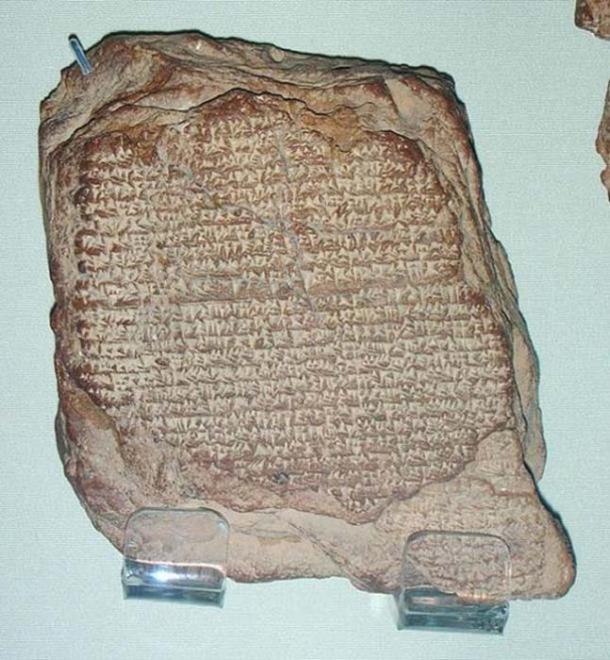Ancient Comet Sightings Inspired, Frightened, Dazzled, and Baffled Past Astronomers and Star Gazers
Since the earliest days of humankind, our ancestors looked into the night sky and watched bright celestial spectacles we know today as comets. While modern astronomers have a rich understanding of the phenomenon, ancient comet sightings were thought of as heavenly messages and were often feared as omens of ill fortune.
Chaldean Astronomers Sight Comets
The European Space Agency website informs that the first systematic observations of the sky can be credited to the Chaldeans, who lived in the region of ancient Babylon, or modern day Iraq, around the third millennium BC. Clay tablets with explicit references to comets date from the last few centuries BC, but indirect sources, for example, the Roman philosopher Seneca, report that Chaldean astronomers had a keen interest in comets for a very long time.

Observation of Haley's Comet, recorded in Cuneiform on a clay tablet between 22-28 September 164 BC, Babylon, Iraq. British Museum, London. ( Public Domain )
Comets in Ancient China and Egypt
In ancient China, where events in the sky were believed to reflect events on earth, a comet suddenly appearing in the sky was thought to herald something of importance that was about to happen on earth, perhaps a major battle or the death of a noble. Chinese records of comets exist at least as far back as 613 BC, and historians believe records had been kept for many centuries before then. Ancient Chinese astronomical data accuracy is unsurpassed and was not overtaken by Western accuracy until the 15th century. This is demonstrated, for example, with Halley’s comet, which appears in the sky every 70 to 75 years and was painted by Chinese astronomers from about 3000 years ago.
- The Comet that Changed Civilization – And May Do Again
- Myths and Meteors: How Ancient Cultures Explained Comets and Other Chunks of Rock Falling From the Sky
- Scotland’s Catastrophic Comet Conspiracy

Detail of astrology manuscript, ink on silk, 2nd century BC, Han dynasty, unearthed from Mawangdui tomb. The page gives descriptions and illustrations of seven comets, from a total of 29 found in the document. (Public Domain )
In ancient Egypt, Pharaonic astronomical texts dating back to the ninth Egyptian dynasty (c. 2150 BC) name 36 stars which rise within 10 days of each other at the same time as the sun. Astronomers under Thutmosis III (1504-1450 BC) also recorded the apparition of what was later named Halley's comet.
Comets in the Middle Ages
By the Middle Ages, fear of comets had reached astronomical proportions and they were believed to portend natural disasters like floods and earthquakes. These so-called “tailed stars” appeared in famous works of art, such as the fresco Adoration of the Magi, by Renaissance painter Giotto di Bondone in the Cappella degli Scrovegni in Padua around 1304 AD. This image gave rise to the widespread belief that the Biblical Star of Bethlehem was actually a comet.

Original Title: Adorazione dei Magi, c.1304 - c.1306, Fresco. Series: Scenes from the Life of Christ. Scrovegni (Arena) Chapel, Padua, Italy. (Public Domain)
A 15th century poem provides historians with an impressive insight into the Medieval beliefs in the supernatural nature of comets: “They bring fever, illness, pestilence and death, difficult times, shortages and times of great famine.”
In 1540 AD, Peter Bienewitz (1495-1552) was the first astronomer of modern times to make the observation that comets’ tails always pointed away from the sun. He wrote about this in his book Astronomicum Caesareum. Three decades later, the famous Danish astronomer Tycho Brahe (1546-1601) measured the parallax of a comet which appeared in 1577 AD to be around 230 Earth radii, corresponding to 1.5 million kilometers. This measurement refuted the teachings of Aristotle, who believed comets to be phenomena generated “within” the terrestrial atmosphere, and Brahe proved that comets were independent celestial bodies.

About a terrible and marvelous comet as appeared the Tuesday after St. Martin's Day (1577-11-12) on heaven. (Written by Peter Codicillus of Tulechova) A depiction of the Great Comet of 1577 over Prague. In addition to the comet, five zodiac symbols appear in the sky: (L-R) Aries, Pisces, Aquarius, Capricorn, and Sagittarius. Below the comet's tail are the crescent moon and Saturn, depicted as a star with the astronomical symbol ♄. At the bottom center, a man draws the comet by the light of a lantern. (Public Domain)
A dispute emerged regarding the trajectory of comets and the cause of their trails, which was presented on the title page of Hevelius’ Cometographia, published in 1665 AD. On one hand, Tycho Brahe predicted that comets would return periodically, however, Johannes Kepler (1571-1630) believed they projected in straight lines. This argument was later settled by Danzig alderman and astronomer, Johannes Hevelius (1611-1687), who proposed that comets traveled in elongated parabolas and hyperbolas, as we now know they do.

Illustration of comet tail shapes featured in Johannes Hevelius’, ‘Tavola N dell'opera Cometographia di Johannes Hevelius.’ (Public Domain)
Halley’s Comet and Hale-Bopp
When we were in junior school, there was only ever one comet talked about, famously named after the 24-year-old Edmond Halley (1656-1742) who in 1680 explained to his friend Isaac Newton that the comet probably had a “sharply curved” trajectory. In scholar Peter Lancaster Brown’s 1985 book Halley & His Comet we learn that with this primary observation, Halley entered a world of celestial dynamics and spherical geometry, and he calculated that the comets’ elongated ellipse should cause it to return in 1758. On the evening of December 25, 1758 the amateur astronomer Johann Georg Palitzsch (1723-1788) reported a weak spot of light in the Pisces constellation… The Halley’s comet returned just as predicted.
Hale-Bopp was the last bright comet seen from Earth. It appeared in the terrestrial sky in the spring of 1997. Since then, comet technology has advanced at such a rate that a mission to comet Wild 2 showed crater-covered “space potatoes” ejecting frozen material into space, which has remained almost unchanged since it originated 4.5 billion years ago.

C/2014 Q2 (Lovejoy) is a long-period comet discovered on 17 August 2014 by Terry Lovejoy. This photograph was taken from Tucson, Arizona, using a Sky-Watcher 100mm APO telescope and SBIG STL-11000M camera. (John Vermette/ CC BY SA 4.0 )
Modern Technology and the Study of Comets
Journeying towards the sun, comet gases vaporize and form a thin extended atmosphere known as the coma. Flows of electrically charged particles called solar winds are generated by the sun and travel through space at a speed of 400 kilometers per second, which forms the comet’s tail - the archetypal aesthetic feature of a comet which can measure 100s of millions of kilometers.
Today, astronomers are performing acts of mechanical and engineering genius which were beyond the wildest dreams of even the brightest minds in ancient history. Comet ‘Tempel 1’ was photographed 67 seconds after it collided with Deep Impact by a high-resolution camera mounted on a spacecraft flying by the event. The following image reveals the comets ridges, scalloped edges and impact craters.
- The Comet that Sparked a Worldwide Flood ‘Myth’
- Was a Comet Swarm Memorialized on an Obelisk at Prehistoric Gȍbekli Tepe?
- Tutankhamun’s Scarab Brooch Was Born of a 28-Million-Year Old Comet Strike

Comet ‘Tempel 1’ passed close to the Sun and warmed up, releasing gases in a process known to astronomers as outgassing, which produces a visible coma and sometimes a tail. (Public Domain)
Space rubble around comets consists of very fine particles and larger rocks which solar winds blow off the surface a comet. When Earth passes through a field of this material, the particles penetrate the atmosphere and appear to race across the sky in a phenomena we call shooting stars. The largest pieces of space rubble that penetrate the terrestrial atmosphere fall to Earth as meteorites.
The Hoba West meteorite impact is thought to have occurred more recently than 80,000 years ago and this space rock is still located on a farm near Grootfontein, in the Otjozondjupa Region of Namibia. Its extreme mass means it has never been moved from the spot it collided with the surface of Earth. Estimated at more than 60 tons, it’s the largest known meteorite (as a single piece) known to scientists. The name "Hoba" comes from a Khoekhoegowab word meaning “gift”, and in an attempt to control vandalism the government of South West Africa (now Namibia) on March 15, 1955, declared the Hoba meteorite to be a national monument.

The Hoba meteorite near Grootfontein, Namibia. (Sergio Conti/CC BY SA 2.0)
Top Image: A foreboding comet crossing the sky. Ancient comet sightings were often linked to important, and sometimes frightening, events in the minds of those who witnessed them. Source: CC0
By Ashley Cowie
References
European Space Agency. (2014) ‘A History of Comets - Part 1: From harbingers of doom to celestial wanderers.’ European Space Agency. Available at:
http://sci.esa.int/rosetta/54198-harbingers-of-doom-windy-exhalations-or-icy-wanderers/
Lancaster-Brown, P. (1985), Halley & His Comet. Blandford Press. p. 76.
Richard, S. & K. Yau. (1984) ‘Oriental tales of Halley's Comet,’ New Scientist, vol. 103, no. 1423, pp. 30–32, 27
Theophile, O. (1903) Ancient Egypt & Black Africa: Karnak House, London, Bibliotheque Egyptologique, Vol.X1.Paris.
The Met. (n.d.) ‘Astronomicum Caesareum.’ Heilbrunn Timeline of Art History. Available at:
https://www.metmuseum.org/toah/works-of-art/25.17/
The Meteorology Society. (1920) Namibia. Available at:



















